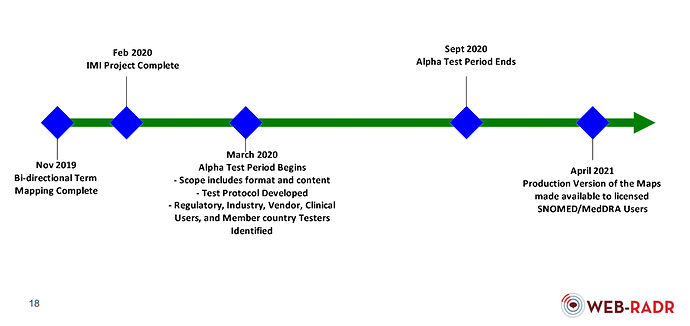Hi all, right now we have around 5k mappings from MedDRA to SNOMED, only for ‘LLT’ class and thinking about add it to OMOP vocabulary.
For example such relationships were built:
| MedDRA_name | MedDRA_code | Relationship | Snomed_name | Snomed_code |
|---|---|---|---|---|
| Abdominal spasm | 10051889 | Maps to | Abdominal colic | 9991008 |
| Incision site pain | 10058043 | Is a | Postoperative pain | 213299007 |
| Streptococcal urinary tract infection | 10070300 | Is a | Bacterial urinary infection | 312124009 |
| Streptococcal urinary tract infection | 10070300 | Is a | Streptococcal infectious disease | 85769006 |
We currently have MedDRA hierarchically above SNOMED (MedDRA Subsumes SNOMED), but if we add the mappings, MedDRA will be below SNOMED (MedDRA ‘Is a’ or ‘Equivalent’ SNOMED).
As example it will change relationship that we have now:
| MedDRA_name | MedDRA_code | Relationship | Snomed_name | Snomed_code |
|---|---|---|---|---|
| Dysphasia | 10013951 | MedDRA - SNOMED eq(Subsumes) | Dysphasia | 20301004 |
| Dysphasia | 10013951 | MedDRA - SNOMED eq(Subsumes) | Dysphasia as late effect of cerebrovascular disease | 441529001 |
will become :
| MedDRA_name | MedDRA_code | Relationship | Snomed_name | Snomed_code |
|---|---|---|---|---|
| Dysphasia | 10013951 | Maps to | Dysphasia | 20301004 |
According to this ‘Classification’ MedDRA concept that has ‘Maps to’ become non-standard and MedDRA concept that has ‘Is a’ become standard, but as we haven’t mapping for all MedDRA concepts, those MedDRA concept will be mixed. I have proposal to implement this step by step:
-
Map only ‘LLT’ concept_class, as they are lowest in hierarchy
-
Leave all other MedDRA concept_class as ‘Classification’.
Will this affect the research that is being conducted? Will it be a good logic? @Christian_Reich, @Dymshyts, @Alexdavv , what do you think about it?

 Any ideas?
Any ideas?